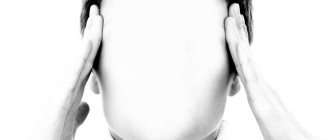.
Each person in his own way is afraid of such a thing as madness. There is nothing surprising. The fear of losing control and losing “control” of one’s own consciousness is quite understandable. But sometimes it acquires ugly features and can spoil the quality of life. Among these are fears associated with VSD, among which the phobia of insanity occupies an honorable place. What other fears can haunt a person with vegetative-vascular dystonia, and how to put an end to this obsessive state?
VSD is accompanied by numerous phobias
Causes of phobia
The primary source of the fear of going crazy is the disease VSD. A person overloads himself with work, there is excessive emotional stress, his living conditions change dramatically: moving to another country, climate change, divorce, etc.
Other causes of fear of death in VSD:
- death of a relative from VSD;
- hormonal imbalances;
- intoxication after taking a course of medications;
- pneumonia at the last stage;
- chronic diseases that influenced the development of VSD;
- mental disorders (prolonged depression, stress);
- gastroesophageal reflux;
- exacerbation of appendicitis;
- alcoholism;
- drug addict;
- back problems, etc.
The patient has been feeling a lack of attention for a long time. He becomes more irritable and excitable even for minor reasons. Because of this, he cannot live a full life.
One reason is lack of physical activity. Due to overwork and lack of sleep, the patient experiences hallucinations. If a person does not rest, a phobia begins to develop.
Lymphomas are malignant cancerous tumors. The patient believes that the headache is caused by a tumor; he is afraid that he will not be able to get rid of lymphomas.
How to properly motivate yourself to eliminate obsessive-compulsive disorder
- Examples of false motivation
Most people believe that the best motivation is when a person wants to be healthy or return to his old life, when he did not have these problems. Let us say right away that both of these motivations do not work. Because as soon as it becomes a little easier for a person suffering from obsessive-compulsive disorder , as soon as the pain and suffering go away, he will stop at a certain stage, and then he will be thrown back - and he will never reach the end. This can be compared, for example, with back pain, when a person does not exercise constantly: pain appears - he begins to do something. The pain ends - he stops. With obsessive-compulsive disorder , the same thing happens, only in terms of agoraphobia - the person began to go out into the street, began to walk around his house, gradually began to get out as far as possible... And when he created a certain comfort zone for himself, he stops further actions, considering , he no longer needs to strain himself.
The motivation “I want to live like before” doesn’t work either. The fact is that it was the way a person lived before that led him to the problems that he has now. It was his thinking, beliefs, and life strategies that led him to obsessive-compulsive disorder , to the fact that he now needs to get rid of agoraphobia and panic attacks. Therefore, in order to cope with this problem, a person will have to change his life a little.
Symptoms of fear of going crazy
You should pay attention to the patient's behavior. He becomes agitated and reacts strangely to familiar phenomena, ceases to adequately assess reality and remains in an imaginary world. The patient perceives surrounding objects as a potential threat to life.
Physiological manifestations of fear of going crazy during VSD:
- muscle tension;
- cardiopalmus;
- profuse sweating;
- fast breathing;
- slight trembling;
- increased heart rate;
- panic attacks, etc.
When the patient himself notices such symptoms, he has a terrible panic. He sees one outcome - death.
A person is afraid of loneliness. Due to deviations in behavior, he is afraid of losing friends.
Obsessive thoughts of suicide are very dangerous. Unable to help himself, the patient considers death the only correct solution.
The patient is afraid of loneliness and loss of friends
Obsessive thoughts, fears and VSD. How to regain a full life Text
When we are nervous and anxious about something, we assume something frightening, we exaggerate (catastrophize) the situation, which, by the way, many people do very often, or, because we are worried about something or someone, we mentally stress ourselves out and for some reason we simply experience, experience a feeling of shame, guilt, jealousy, irritation, resentment or envy, that is, we experience emotional discomfort - this is everything that happens inside us and in our head, leading to tension and stress, and there are internal irritants.
The same applies to pleasant emotions and experiences, only there will be other (positive) reactions in the body based on serotonin and endorphins, thanks to which we can experience joy, peace and euphoria.
The fact is that our brain simply does not feel the difference between what is happening in reality and mental (mental) experience.
Close your eyes and imagine some sexy, pleasant images for you, keep your attention, and you will get excited, or vividly imagining your favorite dish, you can feel salivation.
Note that in reality there is nothing
, you do not make love and do not eat food, but
the physical manifestations are already there
.
All thoughts
, both associated with
a real
event and
a virtual one
, the brain
perceives
almost
the same
. If we only assume (think about) something terrible, but in reality nothing like that is happening now, he will still react to it as a real threat, a corresponding emotional charge will arise, which will trigger a certain set of biochemical reactions in the body, and we will feel certain bodily sensations and symptoms.
If you were examined and the doctors said that you are not sick with anything, the organ that is bothering you is healthy, it means that all the symptoms that you are experiencing now are associated only with your psyche
. The problem is only in your head. You overthink something, perceive it incorrectly and somehow overreact internally.
Let me give you a simple example. You had a fight with someone at work and now you feel some painful, emotional sensations inside. They can be bright or dull and will somehow express themselves with bodily sensations in the heart, head, lungs, stomach, etc., this is because any emotion is always accompanied by
certain physical sensations - take a closer look, and you yourself will quickly notice it.
So, the external situation has already ended, we have separated from the person, but in our thoughts we continue to replay this event, we think up, for example, how and what should have been said, but were not said, we mentally justify or blame ourselves, etc.
Thus, firstly, we do not allow emotions, and therefore symptoms, to gradually fade away; secondly, if we continue to dwell on it, we strengthen them even more.
That is, we ourselves
, with our own thoughts, with our attention to the situation, we intensify bodily symptoms and cause ourselves even more suffering.
I would like to note an important point: everything we feel, all emotional outbursts, some feelings and symptoms can be defined in one expression - internal sensations
.
These sensations, in fact, are a certain set of biochemical reactions in the body, and in particular in the brain.
And this “set” depends on the emotions that we are currently experiencing. For example, the feeling of fear contains to a greater extent a surge of the mobilizing hormones adrenaline and norepinephrine in the blood, and with ordinary anxiety the content of these substances is only slightly increased and passes without surges.
The same hormones enter the bloodstream during any other stressful emotions, for example, irritation, anger, jealousy, depression, resentment, guilt, shame, and are complemented by a corresponding “bouquet” of stress hormones, such as cortisol, aldosterone, prolactin.
And all these chemical reactions in the body are supported by physical reactions - muscle relaxation at rest; muscle tension, increased heart rate, sweating during stress, which only strengthens and maintains one or another internal state.
How is vegetative-vascular dystonia formed?
So, let's go further and look at what vegetative-vascular dystonia is and how it is formed, although I think you yourself have already understood a lot, but something else needs to be clarified.
In our life, all the emotions that we experience, both negative and positive, are all natural.
from nature, and
there are no right or wrong things
that we think we shouldn’t experience. And it doesn’t matter how much we want it or don’t want it, because this is what a full life consists of.
We can experience strong emotional feelings and, under their influence, dive into a cycle of events that take our breath away, and pass bright, powerful impulses of bioenergy through the nervous system, sometimes experience strong feelings of fear or even pain and experience the same intensity of delight and intense excitement.
Many people try, at all costs, to deprive themselves of this versatility and floweriness of sensations, they begin to fear them and avoid them in every possible way, somehow fight it and suppress it. Instead of at the right moment, not paying attention
in response to some natural, albeit unpleasant, feelings that arise, justified for
your
situations, simply accept them and act.
Such people turn themselves, their own “I” into some kind of dullness, and those feelings, emotions and sensations that they so wanted to get rid of, for example, “fear,” become more and more acute in their lives.
When we first begin to meet the opposite sex, it is quite natural to initially experience embarrassment, uncertainty and even fear, because the unknown, novelty and the possibility of failure excite and even frighten us, this is normal
.
But soon, after the first steps, we can experience an incredible feeling of victory, even if we were refused, because we were able to ignore and overcome our fear and embarrassment, we were able to act
, and this is the most important thing.
Another thing is how the person himself will perceive this failure? He will plunge into senseless and harmful self-pity and disappointment due to some kind of failure and, against the background of these emotions, he will experience depression and stress with all its consequences described in this chapter, that is, he will begin an internal crisis. Or a person will simply say to himself: “I could do it, even if it didn’t work out now, but I acted.” And then he will mentally (from the inside) become stronger and more determined, and the fear of meeting someone will weaken step by step.
Dividing emotions and sensations into negative and positive is an old, incorrect approach. In nature, in life itself, there are only pleasant and unpleasant sensations. Nature doesn't give anything for nothing
, there is not a single meaningless reaction or emotion.
For example, the emotion of fear, although very unpleasant in itself, has, in addition to a negative, a positive side, because in extreme situations it helps us survive. Moreover, thanks to this feeling, ours and other living species were able to survive at all. After all, fear mobilizes our body in the event of a real threat, which is why this emotion in psychology is called the “flight or fight” reaction.
Natural (healthy) fear
- This is an ancient instinct of self-preservation, a basic emotion that is
installed by default in all people
.
The very feeling of fear, all this chill (heat) throughout the body, the covering “haze” in the head, internal cringing, overwhelming numbness, fading breath, pounding heartbeat, trembling in the knees, etc., which we experience when we are afraid, how It might not seem creepy, but it’s nothing more than a biochemical reaction
the body to some stimulus (situation, event), that is, this is an
internal phenomenon
based on the release of adrenaline into the blood.
Fear in its structure is, to a greater extent, adrenaline
, plus stress hormones.
Adrenaline is a hormone secreted by the adrenal glands, it affects the body's metabolism, in particular, it increases blood glucose, accelerates heart rate and blood pressure - all in order to mobilize the body.
And when we experience fear, we experience an “ adrenaline sensation” in the body.
And so that right now, you become a little softer about the feeling of fear, you can tell yourself - “the adrenaline is pumping.”
And in life, we very often experience natural fear (anxiety), without even noticing it, it is so intangible.
Examples of such fear:
• you have a reasonable fear of inattention when driving (although there are exceptions) and therefore drive carefully;
• some are more, some are less afraid of heights and therefore, in the appropriate environment, behave carefully so as not to fall;
• you are afraid of getting sick in winter and therefore dress warmly;
• you are reasonably afraid of getting infected with something and therefore wash your hands periodically;
• you are logically afraid of peeing in the middle of the street, so when you feel like it, you start looking for a secluded place, and you don’t run down the street naked simply because a healthy fear of society helps save you from a “bad” reputation that can harm your career.
Natural fear simply plays the role of common sense here. And it is important to understand that fear and anxiety are normal.
functions of the body, but the fact is that for many of you, fear has become irrational and excessive (not useful).
In addition, a healthy feeling of fear (anxiety) always accompanies us in new
conditions. This is fear of the new, fear of losing current, comfortable conditions, fear associated with uncertainty, instability and novelty.
We can experience such fear when moving to a new place of residence, changing activities (jobs), getting married, important negotiations, dating, taking an exam, or even going on a long journey.
He, like a scout in an unfamiliar situation, scans everything around and tries to draw our attention to a possible threat, sometimes even where there is none at all. Thus, the instinct of self-preservation is simply reinsured, because for nature the main thing is survival, and for it it is better to play it safe in something than to overlook something.
Instinct doesn't care how we live and feel
, good or bad, the main thing for him is safety and survival.
of neurotic
grow for us, but more on that below.
We must understand and accept that natural (healthy) fear is our assistant.
, he
is not our enemy
.
Fear becomes an enemy when we ourselves
, unknowingly, make it that way, when we attach
too much importance
and
focus
on it where we should not have done so at all.
Fear has always been and will be
, it’s basically
impossible
, it’s the same as wanting to get rid of skin. The skin, like healthy fear, also performs a protective function; getting rid of fear is like trying to tear off your skin.
And if fear does not lead to panic, does not paralyze our will, and we are able to consciously perceive and soberly respond to it, then everything is fine. And we just need to learn to live
when some fear appears, honestly
acknowledge it
,
accept it
and
be patient
, then it will begin to dissolve on its own without any special consequences for us.
It's the same with doubts. They also play a very useful role if you know how to handle them.
, and can save us from serious nonsense and absurdity.
If you, in a moment of severe anxiety, when some frightening, delusional thought visited you, applied a healthy dose of doubt, for example, asked yourself: “Does what I feel really mean that I am sick? Maybe there are other explanations for this? Can I be completely sure of my terrible assumption? If you didn’t immediately believe
some thought that arose, then now you wouldn’t have your problem.
The feeling of anger, under certain circumstances, is also justified and useful, for example, if you need to protect yourself and your family from bandits, but this does not apply to those cases when a person constantly
because of something he gets irritated and angry.
Natural aggression is a natural, defensive reaction to invasion of personal space, and there is nothing wrong with it for certain situations. Anger, like the emotion of fear, triggers the sympathetic system, only norepinephrine is predominantly released into the blood - a hormone that, like adrenaline, mobilizes our body, but unlike the release of adrenaline, here we feel irritation flowing into anger.
And the fact that we sometimes experience certain unpleasant feelings, sensations and symptoms is a completely normal phenomenon. It is impossible to get rid of some feeling once and for all, only a corpse does not experience anything.
But many people get attached
to the desire to experience
only pleasant
feelings, and
because of this attachment
they have many psychological problems, they do not admit that sometimes it is quite normal to experience some unpleasant feeling and just
take it calmly
.
And to begin with, it is very important to realize that there is no ideally good and constant state in life, and it is impossible
always feel joyful and happy, so there is no point in becoming attached to
illusory
(unfulfillable) desires, that we should live only by pleasant sensations, and allow and
accept everything
.
You may not always be happy, but for the most part you will feel comfortable if you are sincerely content and rejoice at all the good things that you have now, and do not regret what you don’t have. We all tend to be sad and happy, sometimes angry and sometimes funny, sometimes bored and sometimes happy, sometimes experiencing fear and pain, and sometimes intense joy and admiration.
If we had never experienced sadness and grief, we could not
to truly appreciate what joy and happiness are.
A healthy person has changeability of moods and feelings,
and
he knows how to express these feelings
, and not suppress and accumulate them in himself.
And all we can strive for is to make sure that in our life there are more and more pleasant sensations, joy, peace and happiness, but this does not mean that we will always feel joy and not experience unpleasant emotions.
But it’s a completely different matter when fear, anxiety, depression, irritation, resentment or guilt become constant companions of life, when all attention is focused on them and a person is often worried, without realizing the reasons for his worries. And in everyday situations, he is almost constantly exposed to one or another unpleasant emotion that provokes stress.
When a person often experiences tension and stress, it turns out that the part of his nervous system responsible for arousal and mobilization, to a greater or lesser extent, is working all the time. This does not allow him to completely relax, he is tense all the time, the overall balance in the body is disturbed, he is exhausted
.
And at the same time, the parasympathetic system
, responsible for relaxation, restoration and peace, is almost not turned on. I am sure there are those among you who cannot even remember what complete relaxation and peace is.
The nervous system is gradually weakened, and now the person reacts more receptively to everything. The cardiovascular system malfunctions, and repeated bodily symptoms and sensations gradually become chronic (permanent) and often arise on their own at the slightest irritant, including when the weather changes.
This is nothing more than vegetative-vascular dystonia. VSD, I repeat, is when there is no physical illness, but some painful symptoms are really present. A person really feels them, although medical examinations prove that the organ(s) are healthy. The body is sick, and the reason is not physical (organic), but psychological.
That’s why in psychology they say psychosomatic disorders. Somatics means the body itself, our organs themselves. The prefix “psycho” here means a mental factor affecting the body (organs).
By the way, in the international classification of health care there is not even such a disease as vegetative-vascular dystonia, because it is not a disease at all, this diagnosis is made only in the countries of the post-Soviet space.
And according to scientific data, in more than 80% of cases, the reasons for the diagnosis of VSD are tension and stress
, which a person often experiences for some personal (internal) reasons.
If we imagine for a moment that stress did not exist at all, we would have a wonderful, happy life and, no matter the circumstances, we would always feel good.
But tension and stress are not to blame, these are all the same reactions (symptoms) of the body, as in the case of a hot frying pan, when, having grabbed it, we feel physical pain, the pain will instantly show us the cause.
In the same way, tension and stress, in addition to real situations where they are completely justified, very often indicate to us that we are unjustifiably stressed, in vain, just because of some of our wrong views, false beliefs and rules.
And that we internally perceive something distortedly, in a bad way, and have a painful (prejudicial) attitude towards something. For example, we often get angry, constantly blame ourselves or others, get upset because of unfulfilled expectations, envy, get offended and anxious for all sorts of reasons, or feel dissatisfied with ourselves and others.
All these stressful emotions trigger the autonomic nervous system, and at such moments of experience we always feel something unpleasant inside ourselves.
That is, the deep cause of stress, tension and most unpleasant sensations (symptoms) are only within us, in our painful perception of certain situations, thoughts, people and life in general.
Some people are calm about the opinions of others and easily react to insults and criticism, while others react very painfully; speaking in public can be excruciating for many, but enjoyable for others; Some will calmly react to a child’s crying, while others will be unnerved by any noise and even complete silence.
But many people see the reasons for their bad mood, their problems, failures and experiences not in their perception of events, but only in other people and external circumstances, but this has only an indirect meaning
, although many people think that this is not the case.
Of course, situations can be very difficult, for example, the loss of a loved one or a serious injury can lead to very difficult, emotional states. However, all the described reactions in the body relate to the same perception of events and proceed according to the same scenario and have the same nature. Everything, one way or another, depends on our internal attitude towards certain events, facts and circumstances.
If you begin to learn to observe yourself in the right direction, to grasp and realize where and why you are experiencing stress, you will begin to proceed from your personal, conscious perception of life and at least assume that there is something wrong in your worldview, that somewhere There is a harmful misconception - you, too, will gradually understand that the main cause of stress is inside you.
When we are internally calm and when our psyche and nervous system are in order, when we look at life soberly, we react much calmer
even for
serious
situations.
Even now you can look into your past, remember and compare some unpleasant events, where in some situations you felt very bad and you perceived everything gloomily. But in your other state, when you were in the mood and felt mentally calm and confident, such unpleasant events (if they happened) almost did not affect you, you treated the situation with coolness.
And now I would like you to remember a very important point: stress and tension, in addition to the fact that they are most often the main causes of mental and physical suffering, take away a lot of our vital energy, exhaust us, spoil our mood and relationships with loved ones, and disrupt our plans lead to chaos in the head and chaos in life. They always tell us
, that now there is some kind of conflict, struggle, resistance and disagreement with something going on inside us, they tell us that we must pay attention to something within ourselves, realize and analyze some deep things that do not give us peace, draw conclusions and begin to treat this differently (
calmerly
) than before.
The most common symptoms of vegetative-vascular dystonia
As for the various symptoms that you may experience with vegetative-vascular dystonia and in life in general, I will list the most common.
• Sharp and frequent fluctuations in blood pressure, often upward.
• Cardiac manifestations: rapid heartbeat (tachycardia), interruptions in its work, freezing in the heart and tingling (pain) in the heart area may occur.
• Breathing symptoms: rapid breathing (tachypnea), shortness of breath or difficulty breathing, it may seem like you can't take a normal breath and you may feel like you're short of air.
• Coldness in the extremities, associated with a flow of blood to the muscles when a feeling of fear and severe anxiety appears.
• Fever and chills, nausea, a lump in the throat, and stomach cramps often occur, sometimes very painful, but not in any way related to the food consumed or physical disorders. In some cases, there may be frequent diarrhea or constipation, which is associated with the redirection of certain processes in the body at a time of fear or severe anxiety.
• Absent-mindedness and decreased performance. Chronic fatigue, fatigue even with light exertion, depression and irritability.
• Headaches, poor sleep, sensitivity to weather changes. Some involuntary shudders and convulsions, tremors in the limbs, although this may not necessarily be associated with VSD.
• Depression, panic attacks, agoraphobia and other mental disorders, especially against the background of frequent lack of sleep.
VSD is most often a manifestation of neurosis.
When diagnosed with VSD, all these symptoms are not life-threatening in themselves, although some of them can be very strong and even cause panic attacks.
This happens because you are focusing all your attention on them.
, mentally and emotionally, you have screwed yourself up and continue to screw yourself up. You think that you are sick with some kind of physical disease, although this may not be the case at all, and these are just consequences of the work of the autonomic nervous system, which, in most cases, is so.
But you have convinced yourself of something and now unconsciously believe your frightening thoughts, thereby triggering internal, stressful, biochemical processes in the body.
Everything described here is the relationship between the body and the psyche. From here you can conclude that all our thoughts that provoke any emotions do not pass without a trace for us.
By experiencing dissatisfaction, internal resistance, conflict with someone (something) or with ourselves and disagreeing with reality, we have a negative impact on our current state and health in general.
I hope all this at least hints to you in which direction to look and that most of our diseases and all mental disorders (with the exception of a physical factor - injury, serious illness, congenital disorder) come from ourselves
, which means they depend on us, and we can change a lot.
Thoughts, perceptions and reflexes
Now let’s look at why everything happens inside us, how it happens, and why it’s impossible to fix something right away.
So, our thoughts and attention can influence the functioning of the nervous system, and now let’s look at what “thought” and “reflex” are. This is important to know, because most of our problems begin with thoughts, and due to reflexes, all this is maintained and formed.
In the internal processes of the body, the most important role is played by “ thought”
" Thought is not only something virtual (mental), as many people think, it is a connecting link.
Any thought leads to one or another impulse, electrical activity of neurons, that is, an electrical impulse arises in the brain ,
which is perfectly recorded by modern MRI (computer tomograph). Thus, thoughts affect nerve cells located throughout the body.
Over time, all these reactions
in our brain and body
with the participation of thoughts (impulses), neurons and nerve cells become reflex
.
Reflex
- this is a formed
stereotypical, automatic
reaction of a living organism to any stimulus.
To make it more clear to you: if some terrible event happens or the same thought comes to you several times
, for example, some kind of disturbing thought to which
you reacted with the emotion of fear
(frightened), and in the future this situation
will repeat
, that is, the same or similar event will happen again or the same thought that frightens you will arise, then to this situation or a thought can
develop its own conditioned reflex
- a so-called
emotional attachment to this thought or situation
.
If the thought is frightening, then, accordingly, the emotion of fear plus involuntary movements of the person will flare up.
And if this reaction is repeated again and again, it will become entrenched in the unconscious psyche, and then everything will happen unconsciously, automatically
.
The formula is:
Thought (situation) → automatic reaction = reflex
The same thing will happen if some thought (situation, person, phenomenon) causes anger, and this continues to repeat itself
, the emotion of irritation may become attached to this thought or phenomenon, and in this or a similar situation the person will instantly experience irritation.
In very simple terms, an emotion is attached to a thought,
which subsequently
spontaneously
at the mere appearance of this thought.
All this becomes possible due to the fact that stable neural connections
, they consolidate in our psyche previously experienced vivid emotions, as well as habits and beliefs.
Our entire brain is permeated with billions of neurons, basically, its work is based on them, I will omit the details here, we will leave all these nuances, such as triggers, patterns, limbic and reptilian brains to scientists, but it is important for us to know only the most necessary.
But these neurons do not work on their own (alone); various internal functions and processes can only occur through the interaction of neurons with each other
.
The interconnection of certain neurons is responsible for a certain emerging
an emotional reaction (emotion) to some kind of
stimulus
(situation, phenomenon), be it external or internal.
Thus, for each
situation, some kind
of
neural connection is formed, provoking the appearance of a certain emotion.
If a certain person or even food began to evoke in you, for example, a feeling of disgust, and you notice that this has developed into constancy, then this is not only due to the personal opinion that has developed regarding this. This “opinion” begins to be reinforced and retained by the formed neural connection in the brain, automatically causing this sensation.
Each of us has many such neural connections, and they are all responsible for something within us.
. This is what underpins our perceptions and behavior patterns in any life situations: be it relationships with people, work or attitudes towards money, as well as any of our beliefs.
Neural connection is when a “path” is trampled, as it were.
between certain neurons.
And the more we walk along this “path”, the more repetitions
we stimulate it, the more trampled and stable the connection between these neurons becomes.
This is nothing more than emotional memory
.
And if you are now frightened by some thought, symptom, certain people or situations, and this has already happened 2, 5, 10 times, it means that the “path” between neurons responsible for this event (phenomenon) has become strong, and now this the formed neural network spontaneously and increasingly turns on, which means that the corresponding emotion of fear flares up faster and stronger.
It turns out that fear seems to “get stuck” in the brain and, against our will, wakes up at the slightest opportunity, covering us with a wave of familiar symptoms, such as accelerated heartbeat, high blood pressure, muscle tension, etc. This is how the formation of obsessive thoughts, phobias and PA - using a conditioned reflex
.
That is, as I already wrote above, the following will happen: only this very thought
,
corresponding to
automatically
arise .
That is why people who understand the essence of the problem, radically rethink it, realize all the harm, meaninglessness and absurdity of some of their thoughts and beliefs, do not succeed quickly
eliminate the influence of these thoughts, and they still continue, by inertia, to experience some emotions and bodily sensations.
And any of our beliefs, states and habits, from superficial to deep, are based not only
on our conscious belief in them, but also on this neural connection, which instantly provokes certain reactions in the body.
If it were not for this mechanism, it would be very easy for us to abandon some of our beliefs, to easily change our views and opinions.
Our “faith” in some belief, no matter how strange it may seem, often plays only a secondary role, and first an emotion flares up, which makes us continue to believe in some thought
. And even if you absolutely understand the absurdity of some of your obsessive thoughts and fears, and many people understand, you still cannot get rid of them either by willpower or logic.
What happens is that you can’t seem to believe in the truth, it seems that you are being lied to or that you are lying to yourself, that is, you understand with your mind, but inside, with your heart, you don’t accept and don’t trust.
An emotion stuck to a thought simply does not allow one to free oneself from a harmful belief.
The same thing happens with our states: when the body and brain get used to reacting with the same reaction to some situations.
If a person is used to being irritated often, he will continue to get angry even for a minor reason, and this reaction will become more and more progressive if nothing is done about it. The psyche simply gets used to experiencing some emotions, and these emotions become dominant and over time begin to act as a background.
Imagine that you turned on music in the room and went about your business; you may not listen to the music, but you will still hear it. Any feelings, for example, resentment, guilt, depression, irritation, sadness, anxiety, etc., can become approximately the same constant (frequent) background.
And when for some reason, for example, because of a breakup or a feeling of despair, sadness and depression arise for a long time
continue, a person allows himself to become fixated on this day after day, then the corresponding reactions are fixed in neural connections and already at the
biological
level provoke the constant appearance of stress hormones, from which deep depression can develop. And, a person, even with all the desire and effort to get rid of it, will continue to feel sad.
How to quickly overcome panic attacks
A panic attack is a pronounced sign of fear of going crazy; it occurs because a person is afraid of losing control over himself and his actions. It may begin with a premonition of suffocation, impending fainting, or dizziness. Trying to stop these processes, the patient experiences fear and severe stress.
He refuses to accept his phobias and the presence of VSD. An uncontrollable hysteria can start at any moment.
Manifestations of a panic attack:
- nervousness;
- excessive physical activity;
- sweating;
- chills, etc.
The patient experiences derealization - a feeling of unreality. Then depersonalization appears. The person refuses to perceive mental processes and is afraid of developing schizophrenia.
The duration of a panic attack is different for everyone. On average, its duration is 15-30 minutes. In the process, the facial expression changes. The person begins to scream and contort in pain, and may clasp his head in his hands. At this stage, you should urgently consult a doctor to verify the presence of VSD and begin treatment.
How to create motivation for yourself to get rid of obsessive-compulsive disorder:
- You need to create a list of goals that will ignite you, captivate you, and encourage you to take action aimed at getting rid of your problem.
- You should find a community of like-minded people - that is, a group of people united by a common goal. But this is precisely a community of people who will support you on the path to getting rid of obsessive-compulsive disorder , panic attacks and VSD, and not discuss these problems. A development-oriented community where you will find maximum support.
And we must always remember that you can get rid of obsessive-compulsive disorder if you change a certain way of thinking that led to these problems.
Accompanying illnesses
Fears with VSD develop under the influence of various mental disorders. They arise due to the lack of treatment for various chronic diseases.
Concomitant diseases that exacerbate fears of going crazy:
- Schizophrenia is a progressive mental disorder that appears due to the fact that a person loses the unity of mental functions. The patient perceives the world as chaos, begins to fear everything that surrounds him, refuses to communicate with others, and becomes withdrawn.
- Cardiophobia is the fear that the heart will stop. The patient begins to monitor his health, is examined, and in case of minor tingling in the chest, calls an ambulance.
- Agoraphobia is the fear of being in a crowded place. The patient avoids crowds of people. He does not visit cultural institutions, squares, hospitals, concerts, etc. He spends his free time at home alone, wanting to go back in time and correct the situation.
The development of death phobia is influenced by diseases not related to a person’s mental health. Before you begin treatment for death phobia in VSD, you should undergo an examination. It will help determine the presence of other diseases.
Patients with VSD are often susceptible to agoraphobia
How do obsessive fears develop: PA, OCD?
For a better understanding, I will give a common example of a mother who has a small child.
Previously, this mother did not have any particular problems, but now she does not get enough sleep, is tired, nervous (for various, mainly everyday reasons), anxiety is intensifying, and various ailments are becoming more and more apparent: weakness, dizziness, etc.
And suddenly, at some point, she begins to experience certain, frightening symptoms or some thoughts related to herself or her loved ones. It could be anything, such as “why is my heart pounding so much?” or a memory comes to mind from the news about someone killing their child, etc. (there are many options).
And this mother can immediately try everything on herself and think, for example: “Can I do something like that?”
This thought is even more frightening, and here a chain of frightening reasoning may begin: “How could such a thing come to mind, I shouldn’t have such thoughts, maybe I’m abnormal, because normal people don’t have such thoughts, and if I think so, Then maybe I really can do this?”
In a person, against the backdrop of severe stress, the line between emotions, actions and reality dissolves , that is, the difference between thought and action seems to disappear, this leads to a painful feeling that all this can really happen.
And in the future, a person may develop more and more confidence that he does not control his emotions and, if he has some kind of thought, then it must happen.
A person here loses sight of the main thing - in addition to emotions and thoughts, there is always himself and his own choice .
After all, each of us has the best ally in life. And this is not the mind at all (the brain is just a tool), but in essence this is our real “I” - the conscious Observer inside us, who is able to not depend on any emotions, states and thoughts.
I repeat, as I wrote earlier, thoughts are not our “I”. Thoughts are only a part of us, because note that in one situation different thoughts can come to us, and we can choose which one to follow.
In a similar vein, events develop in people when frightening symptoms appear, when, just because of ignorance at the time the symptom occurred, they did not understand the nature of its appearance, did not understand the reason why this was happening to them and that this symptom was simply caused by stress and fatigue.
And then they begin to wind themselves up with all sorts of assumptions, in addition they also go to forums, where, having read everything about diseases and tried everything on themselves, they bring themselves to obsessive anxiety, panic and OCD.
Similar thoughts of people in these situations: “And if I think so, then I can do it,” or “I have a terrible symptom, I’m probably sick,” etc., these are evaluative thoughts, a person gives a certain (negative) assessment of his thoughts and the situation as a whole and from that moment triggers the mechanism for the formation of a neurotic disorder.
Note that this “assessment” (interpretation) is associated with disturbing features of a person’s personality.
An ordinary person in good health, having heard something on TV, could also well think: “Could I do this to my child?”, but he would be impartial and simply say to himself: “What nonsense, of course not.” and, without attaching any importance, would soon forget about it. He would not evaluate thoughts, which means these thoughts would not be something frightening and abnormal for him.
OCD, panic attacks and reasons that reinforce and intensify the problem
A person who is frightened by something, consciously and unconsciously, begins to use the so-called “defensive behavior.”
What does protective mean? This is behavior that people with panic attacks, phobias and OCD use to protect (save) themselves or loved ones (those around them).
This behavior is like a “lifeline” helps eliminate the illusory threat and leads to relief, but this is only a temporary salvation, it seems like the danger was avoided, nothing bad happened, but the obsessive fear remained inside , which means the situation will definitely repeat itself.
This defensive behavior has several directions. One of the most common is avoidant behavior. For example, if I think I might harm a child, I will try to avoid it, or if I am afraid of having a panic attack, I will try to avoid places where I have already had it or might have it.
Also, a person may begin to avoid various objects, for example, knives, since he has obsessive thoughts about causing harm, or avoid transport, shops, and in case of an obsessive fear of getting sick, he may wash his hands, his apartment very often and even wear gloves, etc.
Another type of protective behavior is outside help . A person subject to obsessive fears begins to rely more and more on relatives, doctors, medications and some other means - thereby only strengthening this disorder in himself. After all, he stops relying on himself and begins to completely depend on something external and loses the ability to manage his life.
All people with OCD and PA have such protective actions.
Rituals are another type of “protective behavior.” When a person begins to use ritual actions in order to avoid a threat to himself or loved ones. For example, one day he decides to tap his knee 5 times so that something doesn’t happen, hoping in his heart that it will help, or he starts counting numbers to free himself from obsessive thoughts, or as a ritual according to popular belief (used by believers) so that it doesn’t happen bad. And there are many, many different things.
This topic is very broad, and I will not go into detail here, I will only say that these “defensive actions” need to be gradually removed, because this is the main reason holding the problem, although this will be very difficult for many.
But to make this possible, the right, key actions are needed to work with the main causes of neurotic disorders. And now I will tell you about the most important point, what you need to direct yourself to, and about one very serious mistake.
Treatment of phobia of going crazy with VSD
At the first sign of a phobia, you should consult a psychotherapist. The doctor will help the patient determine how the fear of death arose during VSD, tell him how to get rid of it and begin to enjoy life. Another way is drug treatment. To determine which method will be more effective, the characteristics of the course of the phobia are considered.
Cognitive behavioral therapy
Experts recognize it as the most effective way to combat rabies. A conversation is held with the patient about his condition, well-being, and feelings. It is important that the patient is as active and open as possible during the conversation. The duration of treatment depends on this.
The patient must answer the following questions:
- what will happen if I suddenly lose control of myself;
- what will happen if I do something terrible;
- why am I starting to ramble;
- because of which I am afraid of looking like a fool;
- What will people think of me when I'm having a panic attack?
Psychotherapists have noticed that people ask themselves such questions when their fear of going crazy worsens.
The doctor’s task is not to impose “correct” thoughts on the client, but to teach him how to quickly get rid of negative ones. The patient must be able to re-adjust to the positive in the event of a panic attack.
During sessions, a person with VSD learns to analyze his thinking. After the next visit to the doctor, he is able to control every action and predict the possible consequences of his behavior. This helps fight the phobia of death in VSD.
Hypnosuggestive psychotherapy
The technique combines hypnosis and suggestion, and is used only after the client’s consent, or when cognitive behavioral therapy has not produced the desired results.
The psychotherapist forms a new type of thinking and behavior in the patient, who begins to evaluate life situations differently and learns to overcome his fears of going crazy during VSD.
During the treatment process, the patient does not have an artificial defensive reaction to objects of phobia. This is achieved through hypnosis.
The easiest way to put a patient to sleep is with the help of sounds: the sound of the sea surf, white noise, birdsong, etc. The melody should not be intrusive. Next comes the process of suggestion.
The doctor quietly convincingly explains to the client how to behave when a panic attack occurs. It instills new attitudes towards a healthy lifestyle. After leaving the hypnotic state, the patient feels a surge of vigor.
Manifestations of obsessive thoughts during VSD
Intrusive thoughts in VSD are typically assessed within the framework of obsessive-compulsive disorder (OCD).
They can have varying degrees of manifestation, but in any case they significantly ruin the patient’s life. It is impossible to relax and calmly think about something pleasant - everything is replaced by bad pictures. Everything that the patient sees around him is somehow mixed in his head with death or becomes part of new, even more terrible fantasies. The most common manifestations of OCD:
- Doubt about your actions. Did I close the balcony door before leaving for work? Have you turned off the gas? It gets ridiculous, but sometimes a person has to photograph all the sockets at home and film the process of locking the door with a key. Only by reviewing his “evidence” does the patient calm down and relax.
- Rituals to save lives. A person, having left the apartment and taken the elevator down, may suddenly go back home to eat a mint candy or comb his hair three times. He truly believes that this will save him from potential death. And he has no time for fun. Such rituals exhaust both soul and body. Sometimes the patient falls into the trap of his own rituals. He can simultaneously say to himself “Wash your face” and “Don’t wash your face” and suffer greatly: after all, only one of the two rituals will save him, but which one?
- Imagining death - your own or a loved one. Fantasies can stick for a long time, tormenting and frightening the patient. And a person is unable to prevent these terrible images from appearing in his head. At the same time, the patient feels guilty and is afraid of “causing trouble” with his obsessive thoughts.
Drug treatment
Drug treatment is prescribed in conjunction with psychotherapy. Medicines are used to quickly relieve panic attacks, but they do not eliminate the disease.
Main drugs:
- Antidepressants relieve the patient from depression or stress. The course of treatment is 3-6 months.
- Tranquilizers quickly eliminate feelings of anxiety, help fight objects of fear, and reduce the manifestations of panic attacks.
The phobia is treated with B vitamins. They improve and normalize the functioning of the nervous system. Helps relieve stress, fear, and rage.
Herbal remedies do not help eliminate panic attacks. They have insufficient sedative effect, but can be used in conjunction with chemical agents.
Vitamin B stabilizes the nervous system
Traditional treatment
To rid a person of obsessive thoughts, experts prescribe strong sedatives and tranquilizers, for example Anaprilin.
In general, in such a situation, the following groups of drugs are prescribed:
- antidepressants;
- sedatives;
- anxiolytics.
These medications will help the patient calm down, eliminate a high degree of anxiety and pay less attention to worries.
Constantly taking this type of medication has its negative sides:
- the need to constantly spend considerable sums of money on their acquisition;
- the presence of restrictions that do not allow you to fully enjoy life;
- the likelihood of adverse reactions from the body;
- resumption of obsessive thoughts after drug withdrawal;
- There is a small chance that even constant use of high-quality medications will help you get rid of obsessions.
Self-treatment and prevention of phobias
There are patients who are able to accept their illness. They understand that if certain actions are not taken, the disease will worsen. To stop the development of death phobia, they should:
- reduce anxiety;
- do not carry out actions that cause irritation and fear;
- expand your worldview, especially in the field of medicine and psychology;
- work on self-esteem, etc.
Creativity will help you get rid of a phobia. This could be dancing, singing, drawing, knitting, or putting together puzzles. The main thing is that all the patient’s thoughts are directed towards the product of creativity.
Another way is aromatherapy. Turn on calm, relaxing music. Fill the aroma lamp with your favorite herbal infusions. Turn off the lights and close your eyes. Think about something good that makes you feel good.
Remember, self-medication is not a safe method of treatment. It will help only in the initial stages of the disease. It is necessary to consult a doctor and begin to effectively get rid of the phobia of going crazy with VSD.
Singing will help you get rid of phobias
Recommendations for a panic attack
When a panic attack is approaching, wash your face, neck and hands with cold water. Drink sweetened water.
If you are at home at the time of the attack, take a horizontal position (especially in cases where you feel dizzy or have high blood pressure). Let your body relax. Do breathing exercises - slowly inhale and exhale.
Focus on pleasant memories. Think about your loved one or loved one.
If no action is taken, a stroke may occur, so medical help is required.
Panic attack and VSD: treatment at home
A person who has experienced PA before often experiences intense fear of another attack. And it is these experiences that cause more significant harm than another attack.
Prevention
For patients with diagnosed vegetative-vascular dystonia, in order to prevent exacerbation, blood vessels should be treated and strengthened. To overcome VSD, you need to adjust your lifestyle, daily routine, diet, level of physical activity, and bad habits. At a minimum, avoid smoking, alcohol abuse and caffeine-containing drinks.
The main method of preventing panic attacks is to stop the accumulation of tension in the muscles. The state of tension is caused by the hormone adrenaline, released in response to real or perceived stress. The following methods will help remove the remaining adrenaline.
- Hard massage of the large muscles of the body. Helps speed up microcirculation and metabolic processes and remove the hormone through sweat and urine.
- Physical activity in the fresh air. For example, Nordic walking is an ideal workout for the cardiovascular system and for correcting musculoskeletal problems.
- Relaxation breathing exercises (qigong, yoga) will help relieve muscle tension and calm the nervous system.
- Thai boxing. Punching bags can be found in almost every fitness club. What you need is a punching bag that resembles the human body. When making sharp kicks and punches while exhaling, large muscles are activated, which contributes to the controlled release of adrenaline into the blood and its waste.
If an attack occurs
How to cope with VSD, panic attacks, neuroses on your own if an attack is on the way:
- Switch thoughts from your inner world to the environment: carefully examine the elevator buttons, the color of surrounding objects, listen to music, and so on. You can call a friend and get distracted by the conversation.
- If possible, lie down to relieve muscle tension.
- If you have trouble breathing and there is no paper bag nearby, you can breathe into your palms. The main thing is to take long exhalations.
- Try to force yourself to smile. The body responds to the produced emotion by normalizing physiological processes.
You can learn more about how to cope with panic attacks and obsessive thoughts on your own











